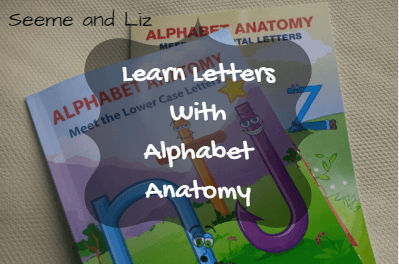This article will be slightly different than what you may be used to seeing on Seeme and Liz! As many of you may know I am a big advocate for learning through play. This article will have more of a traditional educational feel to it. If you haven’t heard of Alphabet Anatomy, it is a series of books by Linda Jones. Linda approached me and asked me to write an article about these books.
How Can Children Learn Letters With Alphabet Anatomy?
Overview of the Alphabet Anatomy books
Linda sent me two books to review: “Meet the Upper Case Letters” and “Meet the Lower Case Letters”. These books are meant to teach children, through visuals, rhymes and alliteration, how to write and remember each letter. These books are not meant to teach phonics (the sound(s) each letter makes). However, the key word for each letter also reinforces the letter sound. As you can see in the picture below the key words for P and Q are “pizza” and “quiet”
The pictures in the books are drawn by Linda’s son Branson. The drawings bring the letters to life and give each letter a personality of their own.

My kids and I read these books together. My 8 year old daughter found them quite funny and still talks about the uppercase B being “2 bellies fat”. She even commented “that makes it easy to remember how to make a big B”.
Each letter is introduced through a sentence or two containing rhymes. I love books that include rhymes as the ability to rhyme is an excellent indicator of early literacy skills. And rhymes are easy for children to remember!
Some of the sentences also contain alliteration. Alliteration and rhyming fall into the category of phonological awareness which helps children connect spoken language to the written word. An example of alliteration in the alphabet anatomy books is “v veers down the valley”.
♥ You Might Also Like: Best Learning Toys For 3 Year Old’s To Encourage Language Development ♥
What is the intended age group of these books?
I asked Linda what the intended age group was for these books and she stated that they are great for any age. In my opinion, I would recommend these books for children over the age of 5 if the focus is on printing. That being said, there is nothing wrong with reading these books to your child as you would read any other book. You do not need to quiz your child on the letters unless he/she has shown an interest or is of the age when letter recognition and printing is being worked on. Draw attention to the rhymes and from time to time ask your child if he can come up with another rhyming word. For example, “top, pop, _____”.
The one thing I did notice is that the words used in some of the sentences are quite advanced. If you look at the description for the letter “v” (see picture below), you can see there are some abstract words such as “veers” and “ventures”. These are going to be quite difficult for a young child to comprehend. It is extremely important for children to have a varied vocabulary and introducing them to more complex words is great, however in order for a child to make sense of these words and truly understand them, they need to hear them often and the word needs to be explained to the child in as many was as possible.

My overall thoughts about the Alphabet Anatomy books
Would I recommend these books for teaching letters and helping children learn to print letters? Yes, I would.
I love that each letter has its own personality. I also really like that the phonological awareness skills of rhyme and alliteration are targeted in these books.
However, the vocabulary used is quite advanced and may be above what young children can comprehend. And remember, young children learn best through play. Incorporate story time into your child’s day and have fun reading books such as the Alphabet Anatomy books.
These books would be great in a Kindergarten or Grade 1 classroom reading area for children to explore freely. They could also be used during group reading time led by the teacher. At home, these books will make a great addition to your child’s bookcase.
Take a look at the Alphabet Anatomy website for information on early literacy and pre-literacy skills as well as to purchase the books. You can also buy these books on Amazon! In addition to the two books that I discussed today there is also a parent guide and an activity and coloring book available.


